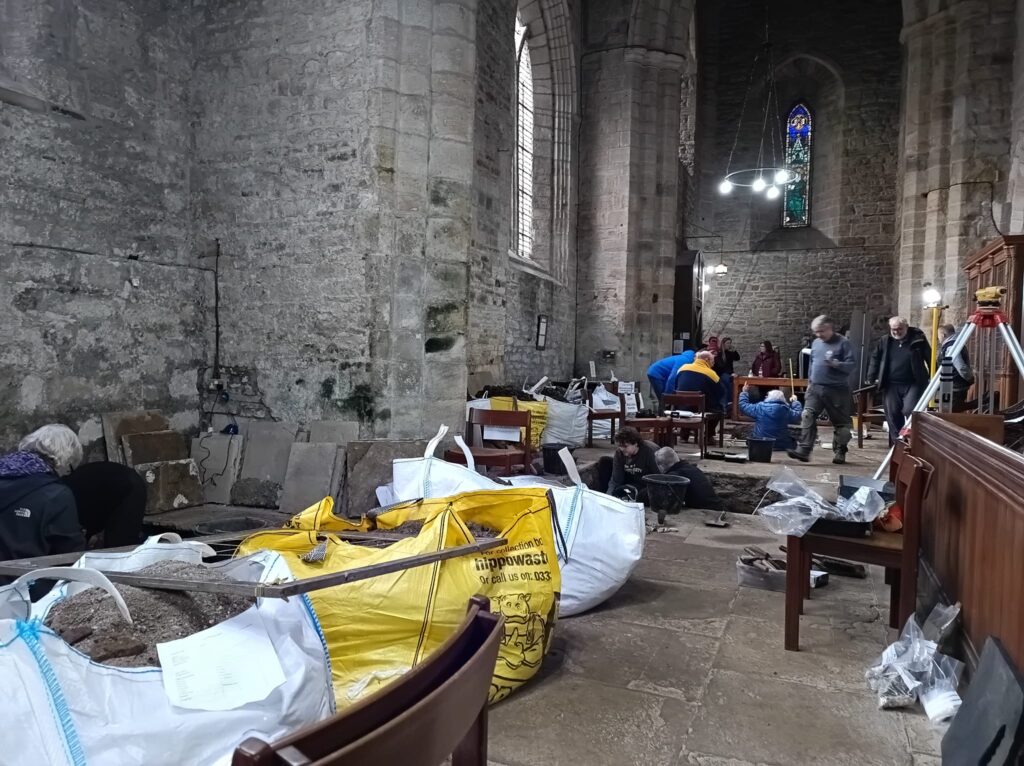
Dr Sheila Newton, one of our volunteer archaeologists brings you updates from the trenches….
Day 1 – Weds 25th January 2023
Rob, Andy and I were at the Abbey for 8am to let the stonemasons in. Yesterday they took up the flagstones from the floor for trenches 3 and 4. Today they took up the floor for trench 2. All these trenches are inside the Abbey.
We had 3 volunteers in the morning who set to removing the fill in trench 4 (near the font) that had been placed under the floor to level it. This fill looks as if it was brought – tons of it – from the local mines. It’s sandy material with bits of coal, quartz and stone, amongst other things, mixed with it.
Along the side side of the trench an area of stones began to be exposed and the 4 afternoon volunteers partly cleaned it as well as taking out most of the fill and starting on the fill in trench 3 (near the arch). We’re not sure what the stones are covering in trench 4 – there’s a void underneath them. Hopefully we’ll learn more tomorrow.
We had a number of visitors, many of whom were interested in what was going on, whether they were local or not. Fortunately we had a volunteer who explained things to them.
Day 2 – Thursday 26th January 2023
Work began at 9am today, our usual starting time. We had just one volunteer this morning. He cleared a lot more of the fill from trench 3 and helped to clean the stones that were exposed. We’re hoping that these will prove to be evidence of an earlier building.
Rob, Andy and I worked on trench 4 while trying to work out what we’d found. We cleaned, photographed and drew on the plans the stones that had been exposed. Later, although we had no afternoon volunteers, we were able to lift the very top stones. We then photographed and planned the feature again. Both times we used a dumpy level to measure how the feature related to it’s surroundings. Volunteers will get an opportunity to do some of these tasks in due course. Lifting more stones is a job for another day.

The quiet afternoon gave us a chance to to see what progress we had made (very good) and to plan a bit what comes next.
There were fewer visitors today but many were intrigued with what we were doing, so I did what I could to make sure they enjoyed their visit. It’s always good to have visitors to a dig.
Day 3 – Friday 27th January 2023
Archaeology is a destructive process, as anyone who has done any will tell you. This is why everything is recorded in such detail at every stage – nothing can be put back exactly as it was and, usually, no attempt is made to do so.

The volunteers today – one in the morning who stayed all day and two more in the afternoon – were a good help. They not only assisted with the digging but did much of the recording, too, drawing the plans of the feature in trench 4. When we were satisfied that the feature was recorded as well as possible, we took the top layer of stones off exposing the most beautifully built drain. The base was comprised of re-used stone roof tiles and the sides, perfectly straight on the inside, were made of stacked pieces of tile or other flat stones. Some of the levelling fill had fallen through the capping stones and had to be cleaned out but, looking down the tunnel of the drain, it was perfectly clean and dry. More photographing, drawing and other detailed recording followed. Then the side walls were removed and the base cleaned, photographed, planned etc. You will now understand, if you didn’t before, how archaeology destroys things. As we haven’t yet found the feature we were actually searching for in this trench, we have to continue digging.

Trench 3 had all the levelling fill removed and was cleaned down to a layer of clay and the large stones that were exposed yesterday. More investigation, we hope, will give us clues as to what this is.
Again we had a variety of visitors, most of whom showed an interest, and several local people popped in again to see where we had got to. It was another enjoyable and good-humoured but tiring day.
Day 4 – Saturday 28th January 2023
Our 4 morning volunteers worked hard in trench 3 cleaning it up and exposing more stones. It’s still enigmatic and we’ve yet to decide what exactly is going on in there.
Later they moved over to trench 4 and started to take out the clay layer between the drain and the edge of the trench away from the wall. While some stone slabs began to appear, they also found several pieces of mediaeval glazed floor tile. This was quite exciting and suggests that the floor of the abbey was originally covered with the sort of coloured tiles that you often find in big churches dating from the Middle Ages. Unfortunately the ones we’ve found so far are very worn, but at least they indicate that the floor would have been brightly coloured in the abbey’s heyday.

More photographs, planning and taking levels kept us well occupied.
Although the morning was fairly quiet we had quite a lot of visitors in the afternoon. It’s always interesting to chat to the people who come into the abbey and to explain what we’re doing, as well as learning a bit about what’s brought them there. At one point I was trying to do the guided tour bit using the sort of general information that works for the public when the man informed me that he’s an archaeologist and knows Rob. I was relieved to be informed that my explanation was more than adequate even when given to an expert!
We now have a couple of days off. Since all my muscles are complaining about the unusual exercise they’ve been getting, I might just spend the time in bed…




